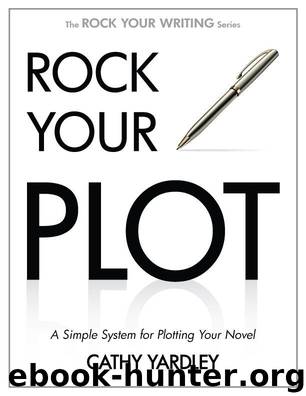Rock Your Plot: A Simple System for Plotting Your Novel (Rock Your Writing Book 1) by Cathy Yardley

Author:Cathy Yardley [Yardley, Cathy]
Language: eng
Format: azw3, mobi
Published: 2012-06-17T04:00:00+00:00
ASSIGNMENT:
Write down your first plot point... basically, your GMC, in one scene that illustrates why it's important and how serious the conflict is.
Chapter 7: Midpoint, a.k.a. Plot Point 2
Plot Point 1 is when your protagonist knows what she needs to do, but has no frickin' idea what to do about it.
Plot Point 2, also known as “the Midpoint,” is when your protagonist figures out what she needs to do. Usually, this involves learning something vital somewhere after casting around and getting blocked left, right, and sideways. The Midpoint shifts the protagonist from reacting and bouncing off of events to becoming proactive, and gaining both direction and momentum.
This proactive quality is usually the best way to define a midpoint, in my opinion.
The midpoint is also an escalation. Now that she's pieced together how she's going to achieve her story goal (generally speaking, anyway) it's best to ramp up the other two elements of the GMC equation. When that the goal appears to be achievable, turn up the motivation, and turn up the conflict.
Turning up the motivation.
Let’s say you’re writing a romantic suspense. The hero is a private investigator, and he thinks that the heroine might have stolen money. Plot Point 1: he rents a room in her house to keep an eye on her, pretending to be a handyman, getting closer to her. By the midpoint, something happens… someone tries to kill her. He realizes at that point that while he’d seen clues that pointed to her innocence, he now understands that not only is she innocent, but she’s been set up and she’s in real danger. Being the kind of guy he is, he’s not going to just take his fee and let her fall. He is falling in love with her and feels compelled to take action to save her.
New information is introduced.
I got this handy tip from Larry Brooks’ wonderful Story Engineering, and it changed the way I look at midpoints forever. In order to shift the protagonist from reactive to proactive, he needs to learn something new that clears up the solution. It doesn’t actually solve the problem, but it gives him a roadmap and allows him to actively pursue a clear goal. At plot point 1, he had a ton of options, but no clear path. Now, he’s got a path – usually with a ton of obstacles, but still more direction than he’s had up to that point.
Choices are made.
It also means that some of his options are pruned, which is great, in terms of your story. When he gets to the inevitable climax, you want the reader to feel that given the character he is and the choices he’s made, he has no other reasonable option. The Black Moment needs to have a ring of inevitability – like a train wreck you can’t look away from.
To do that, he’s got to burn some bridges. The last thing you want is a hero that gets to the resolution, and goes “you know, I guess I want to just run away, after all.
Download
Rock Your Plot: A Simple System for Plotting Your Novel (Rock Your Writing Book 1) by Cathy Yardley.mobi
This site does not store any files on its server. We only index and link to content provided by other sites. Please contact the content providers to delete copyright contents if any and email us, we'll remove relevant links or contents immediately.
Asking the Right Questions: A Guide to Critical Thinking by M. Neil Browne & Stuart M. Keeley(5357)
Autoboyography by Christina Lauren(5088)
Dialogue by Robert McKee(4160)
Eat That Frog! by Brian Tracy(4149)
Sticky Fingers by Joe Hagan(3912)
Journeys Out of the Body by Robert Monroe(3461)
Annapurna by Maurice Herzog(3300)
Full Circle by Michael Palin(3268)
Elements of Style 2017 by Richard De A'Morelli(3237)
Schaum's Quick Guide to Writing Great Short Stories by Margaret Lucke(3188)
The Art of Dramatic Writing: Its Basis in the Creative Interpretation of Human Motives by Egri Lajos(2858)
The Diviners by Libba Bray(2801)
Why I Write by George Orwell(2775)
The Mental Game of Writing: How to Overcome Obstacles, Stay Creative and Productive, and Free Your Mind for Success by James Scott Bell(2766)
In Patagonia by Bruce Chatwin(2756)
Atlas Obscura by Joshua Foer(2706)
The Fight by Norman Mailer(2702)
Venice by Jan Morris(2431)
The Elements of Style by William Strunk and E. B. White(2377)
